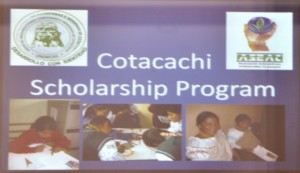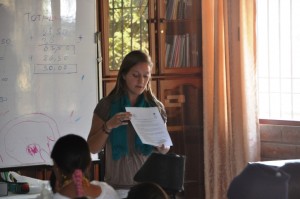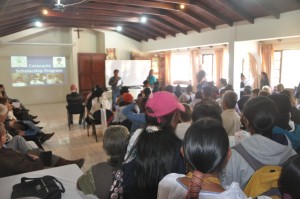What better way to end the year than to start a list of things to do next year. This isn’t my list that follows but there are many things on this list that I want to do next year in Ecuador – Before you read the list though I just wanted to say Happy New Year to everyone and hope things are in Lucky 13!!
1. Watch the Tungurahua Volcano erupt at night from the look out over Banos. Tours can be arranged in one of the many agencies in Baños. Cost $20 per person.
2. Visit the gold mine in Zaruma where resident Spaniards found a 2 and ½ pound piece of gold and gifted it to King Felipe II several hundred years ago, causing the king such joy he decided to lower the taxes for everyone living in Ecuador. The mine is called “El Sexmo” and is now open to tourists with guided tours from actual nearby miners. Free.
3. Observe the amazing Pink river dolphins as they frollic in the unique flooded rainforest of Cuyabeño in northern Ecuador. Tours can be arranged once on the ground out of Quito or Lago Agrio. Canoe Tours start from $40 per person.
4. Scuba dive in the crystalline waters of Galapagos off Floreana Island with hammerheads and whale sharks. 2 Dives start from around $130. Best arranged once on the ground in Santa Cruz Island near the port in Puerto Ayora with local dive shops.
5. Snorkel with the worlds smallest penguin, gigantic manta rays, big marine iguanas and (friendly) reef sharks off las Tintoreras on the picturesque snow-white sands and turqoise waters off Isabela Island in the Galapagos. Day tours to Isabela arranged in Santa Cruz start around $65/person.
6. Eat two buckets of the locally-famous garlic crab at one of the best crabhouses (Manny’s Crangrejal) in Guayaquil, a city known for its numerous crabhouses. Near San Marino Mall any taxi will know where it is. $12.
7. Hunt for fossils along the banks of the Nangaritza River, the only river that connects the Amazon to the Pacific Ocean, high in the Condor Mountain Ridge (Cordillera del Condor). For more try lindoecuadortours.com $25-50 /person.
8. Deep-sea fish for Marlin and Whale-watch in August off the calm shores of Salinas. Trips can be arranged in one of the several agencies along the boardwalk. Cost: Whalewatching from $20 per person, deep sea fishing price varies depending on amount of people.
9. Bike on a rented bicycle from the city of Puerto Ayora in the Galapagos to the deserted, idyllic beach of El Garrapatero while passing through over a dozen micro-climates and witnessing the giant Galapagos tortoises grazing in their natural habitat. Cost: $5.
10. Visit a chocolate farm near Guayaquil and learn the whole process of how to make chocolate from harvest to belly. Get more info here.
11. Hummingbird watch and observe thousands of butterflies in the cloud rainforests of Mindo. Tours can be arranged once in Mindo. Start from $20/person.
12. Climb Cotopaxi, one of the worlds highest active volcanoes at 19347ft / 5897m with a guide arranged in Quito, I’ve been told even beginners can do it!
13. Explore the massive, underground lava tunnels on Santa Cruz Island in the Galapagos. Free.
14. Trout fish in one of the surreal apline lakes in the barren Cajas National Park near Cuenca. Tours can be arranged with Terra Diversa in Cuenca.
15. Go way off the beaten path and discover the Lost City (Ciudad Perdida) of Ecuador’s Amazon. Extreme adventure available through local guides only out of Nangaritza. Cost: Highly negotiable.
16. Pamper myself with a the natural mud bath in the mud pools in the dry rainforest of Machalilla National Park and spend the night playing volleyball with the local indigenous and later sleeping in one of their tiki huts. From Puerto Lopez hire a motorcycle taxi and pay a few bucks from them to take you to the indigenous community of Aguas Blancas in the park. Cost: $10 for the day tour to the mud baths and $10/person for the night.
17. View the thousands of Orchid species growing wild along the well-kept trails of the Podocarpus National Park easily reached in a $4 taxi ride from the town of Zamora. Free entrance to park.
18. Hike the 10km trek from El Tambo to Ingapirca, ancient Incan ruins and effectively Ecuador’s own “Machu Picchu”. You can also take a train, taxi or bus which can be arranged out of Canar. Ruins Entrance fee $6.
19. Get certified as a glider plane pilot in Ibarra through a one month course with a local flight instructor. They say if you can fly a plane without an engine you can fly a plane with one. Course starts around $1300. 2013 prices yet to be released. For more info write me here.
20. Visit the worlds only birds that live in a cave, in the only cave they live in at the CUEVA DE LOS TAYOS. Tours arranged out of Macas. Prices vary.
21. Tailgate, then enter a game in Quitos rowdy Atahaulpa Stadium as the National Soccer team attempts to qualify for the next World Cup in Brazil. The cheap seats start around $10.
22. Learn to kite surf with an instructor against the strangly barren cliff landscapes of Santa Marianita near Manta. Classes can be arranged on site. Prices vary.
23. Party with fun locals along the infamous Plaza Foch in Quito during Quitos Festival Week “Fiestas de Quito” the first week of December. Free if you can find a sugar-momma/pappa to buy you drinks.
24. Take a tour of a Banana plantation in Machala and learn all the ins and outs of the interesting business with CristyViajes. Tours start around $20 per person.
25. Fish for Pirana in Laguna Pañacocha, a beautiful black wáter lake backed by cloud forests. To get there, hire a local canoe where the Rio Panacayu meets the Rio Napo, to get there you’ll need to take a Nuevo Rocafuerte Canoe hired in the town of Coca. Price varies depending on season.
26. Bike the wonderful 7 hour (60km) downhill ride from the high Andes to the mouth of the Amazon in Puyo and witness the furious waterfall of Baños “Pilon de Diablo”. Bike can easily be rented in Banos. Cost: $5
27. Soak in the odd street water-wars during Carnaval in February in Cuenca where everyone goes around throwing water balloons and soaking random strangers with water guns. Free.
28. Hike the Quillotoa Volcano and witness the majestic, stunning turquoise-colored lake in the volcano’s crater. Can be done solo by taking a bus from Latacunga and getting off near the base. Cost: $4 bus fare from Latacunga.
29. Experience the naughty, packed, full-moon-style New Year’s Eve party in Montanita. Free if you sleep on the beach in a tent (doable), just don’t bring valuables.
30. Mingle with sexy locals dressed to the tilt during the 2 hour river-boat cruise on the all-you-can-drink boat ‘Morgans’ which leaves every night from the boardwalk (Malecon) of Guayaquil. Can be arranged out of my B&B in Guayaquil. $15 per person includes all you can drink.
31. Follow the rarely-visited path of the world-famous indigenous Shuar who were the ones that originated the practice of shrinking the heads of their conquered enemies. Tours now available with local guides through Macas or Zamora. Prices vary.
32. Learn to kayak in the lazy to fierce Andean rivers around the city of Ibarra with Natural Adventures. Prices vary.
33. Devour delicious seafood at the locally-famous “Parque de Mariscos” along the beach in Manta heading towards the airport. Specifically I want to eat a ‘Cazuela’ Soup, an amazing nut-based fish soup truly unique to Ecuador. Cost: $6.
34. Have a 10 minute long conversation in Spanish with a local after a month long Spanish crash course at the highly recommended Galapagos Spanish School in Quito. Cost: one-on-one classes with real teachers start around $6/hr.
35. Dance salsa to afro-latino beats on the white-sand beaches at moonlight in a beach bar near Esmeraldas after eating the local delicacy of Shrimp cooked in spiced coconut milk (encocado de camaron). I’m sure I’ll feel like I’m in the Caribbean. Cost: $5-6.
36. Visit the perplexing, friendly afro-ecuadorian community of Chota in the middle of the Andes near Otavalo and have a local Shaman (witch doctor) cleanse away my worries. Cost: $5 bus fare from Quito.
37. Have literally ten years taken off my face through the marvelous work of the locally-famous and reasonably priced Dermatologist Janeth Arevalo in Loja. Men are welcome. Cost varies depending on what is done.




























